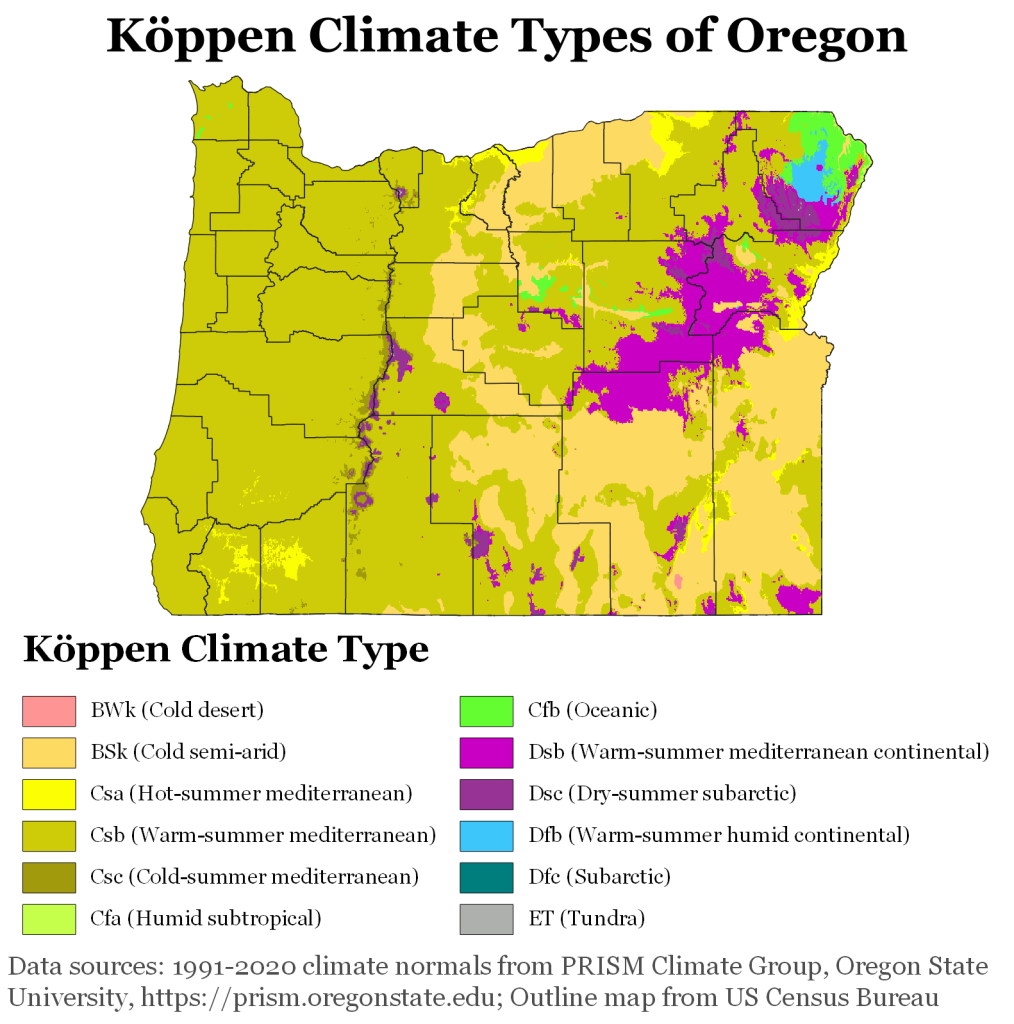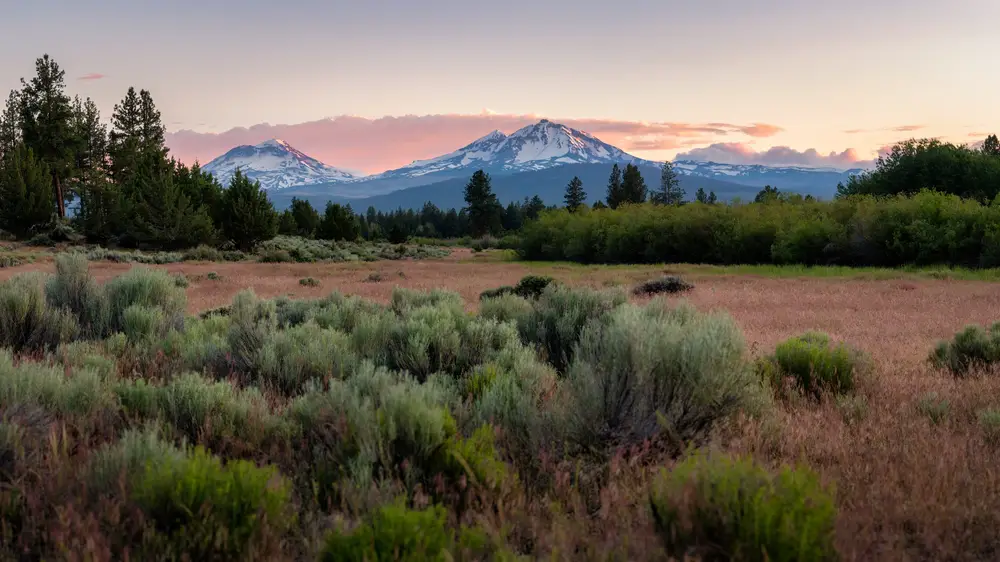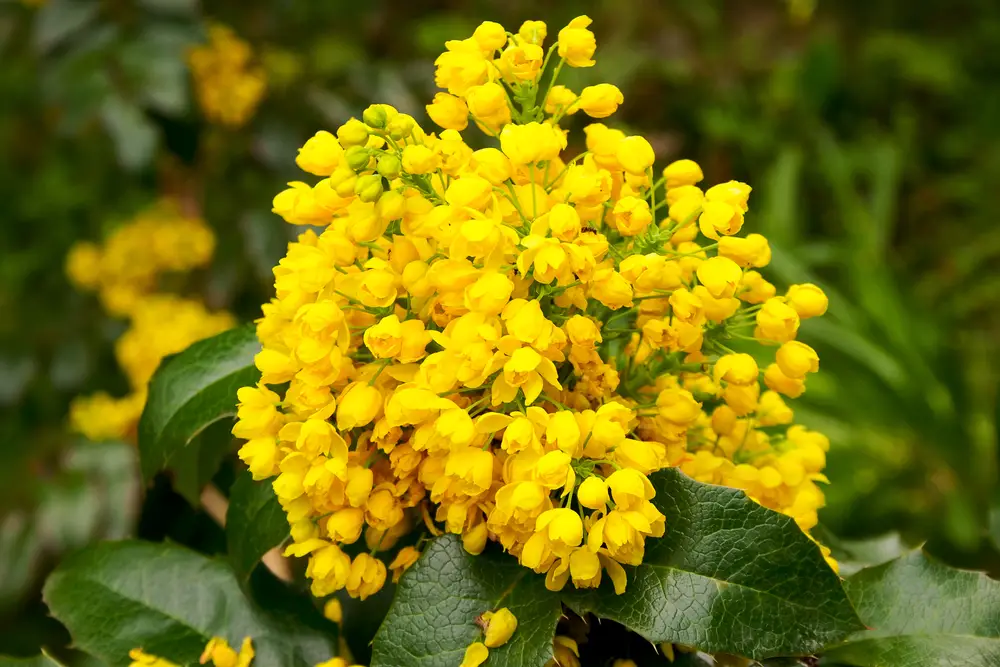Oregon Plant Hardiness Zones
| USDA Hardiness Zone | Average Minimum Extreme Winter Temperature Range Fahrenheit (°F) Celsius (°C) | Average Last Frost Date Range In Spring (Beginning Of The Growing Season) | Average First Frost Date Range In Autumn (End Of The Growing Season) |
|---|---|---|---|
| 5a | -20°F to -15°F-28.9°C to -26.1°C | Early to mid-May | Late September to early October |
| 5b | -15°F to -10°F -26.1°C to – 23.3°C | Early to mid-May | Late September to early October |
| 6a | -10°F to -5°F -23.3°C to 20.6°C | Late April to early May | Early to mid-October |
| 6b | -5°F to 0°F -20.6°C to 17.8°C | Late April to early May | Early to mid-October |
| 7a | 0°F to 5°F -17.8°C to -15°C | Late April to early May | Mid to late October |
| 7b | 5°F to 10°F -15°C to -12.2°C | Early to mid-April | Late October to early November |
| 8a | 10°F to 15°F -12.2°C to -9.4°C | Late March to early April | Early to mid-November |
| 8b | 15°F to 20°F -9.4°C to -6.7°C | Mid to Late March | Early to mid-November |
| 9a | 20°F to 25°F -6.7°C to -3.9°C | Early to mid-March | Mid to late November |
| 9b | 25°F to 30°F -3.9°C to -1.1°C | Mid to late February | Early to mid-December |
| 10a | 30°F to 35°F -1.1°C to 1.7°C | Early February | Mid to late December |
Oregon Growing Conditions

General Climate
Oregon plant hardiness zones range from 5a through 10a. There are many climate regions within Oregon.
The west has a Mediterranean climate. Within this climate range the state experiences:
- Warm summer Mediterranean
- Cold summer Mediterranean
- Humid subtropical
- Oceanic
This area of the state is divided from the rest of Oregon by the Cascade Mountain Range. Winters here are cold and experience higher precipitation in the form of rain and snow. The west’s weather patterns are affected by the Pacific Ocean and cold wind patterns from the Arctic. Summers in this climate region are warm and dry.
Eastern Oregon is a cold semi-arid climate. Within this climate range the state experiences:
- Dry summer subarctic
- Subarctic
- Tundra
This area of the state is dry, with less precipitation than the west. More snow is common here, with colder winters and hot summers.
Some areas within the eastern portion of the state also experience aspects of a continental climate. These areas, while still tropical, are considered to have some continental climate characteristics. This can look like more defined seasons with larger fluctuations in temperature.
This includes:
- Warm summer mediterranean continental
- Warm summer humid continental
Microclimates
USDA plant hardiness zones are an important starting point for your garden, but you’ll also need to consider microclimates.
Microclimates are areas where specific conditions create a climate different from the climate they’re situated in.
Buildings, fences, paved areas, or short hills and valleys can create these microclimates.
They can be as small as a space in your backyard or as large as a city.
In other words, learn about your local conditions from local experts to see if your garden falls into a microclimate.
Extreme Weather
Heavy Precipitation
The coast of Oregon experiences heavy rains from November through to March and can see as much as 200 inches (508 centimeters) annually! The extreme weather is caused by the moist air that flows over the Pacific Ocean and into the state.
Heavy rain for extended periods can cause major flooding in the area.
Having proper drainage around your garden and home is one of the best ways to mitigate against flooding. French drains and rain gardens can help to divert the flow of water from your home and garden space.
Plant trees and shrubs that love getting their feet wet. This helps to remove excess water from your garden space. Trees like willows, swamp milkweed and mountain mint are a great addition to an area where water pools frequently.
Extreme Heat
Southeast Oregon often experiences prolonged heat exposure and high risk temperatures.
Shade tarps are a great way to keep veggies cool during the hottest parts of the day. These tarps are easily put up and taken down depending on how hot it gets day to day.
They help keep plants cool, stop leaf burn, and help retain moisture in the soil. This keeps plants healthy during hot summer days.
Growing Season
Oregon is split into 4 climate regions. Below we dive deeper into each of these areas. We look at their locations and how their topography affects the growing seasons.
Each of these climate regions has varying lengths of frost-free growing days.
The Coast
The coast of Oregon has the longest growing season. Frost-free days range from 190 to 250 days.
The climate is affected by its location to the Pacific ocean. As winds travel over the water the air warms and creates a moderating effect on the weather. This means cooler summers, with cold but not frigid winters.
High winds can be a challenge when growing in this region. Growing the right plants for the climate can make all the difference for succeeding in this area of the state.
The Western Valleys
This region has 150 to 250 frost-free growing days. The length of season in this region varies greatly each year. These valleys are surrounded by the Cascade mountain range.
The topography creates a warmer climate, as the mountains act as a buffer for wind and bad weather coming from the ocean as well as the continental side of the state.
This area has great soil. It is considered to be the best climate in Oregon for growing. Year round growing is possible in the region with the right tools such as:
- Row cover
- Cold frames
- Greenhouses
The Cascade Mountain Range
Central and eastern Oregon have the higher elevations due to the Cascade Mountain range. This makes for a shorter growing season. High elevation desert climates are in this region.
Frost-free days are between 90 to 120, although, there is a possibility of frost at any time during the year.
Rough terrain and erratic cooler temperatures make growing difficult. Using native plants and learning about the soil conditions in this area will lead you to growing success.
Snake and Columbia River Valleys
The valleys located in the northern quadrant of Oregon are the valleys in between the Snake and Columbia Rivers. The growing season here ranges from approximately 120 to 200 days.
This area of the state experiences hot days and warm nights. Heat and wind is a problem for gardeners in this area.
Try building live hedgerows around your garden to create shade and dissipate winds. It is worth mulching heavily in the spring to retain moisture and prevent the wind drying out soil.
Oregon Gardening Tips

Year-Round Harvesting On The Oregon Coast
Oregon’s coastal climate allows for year-round growing of cool season veggies. With a little planning, you can have a year round salad garden, filled with:
- Kale
- Lettuce
- Arugula
- Spinach
- Herbs like parsley can be harvested in the winter season too!
Winter veggies like broccoli and brussel sprouts actually taste better after a frost! This is because starches are released after the temperature drops, which develops the plant’s flavor.
Knowing when to sow seeds is important for harvesting in the winter. Many veggie seedlings need to be started in the summer for fall or winter harvest. Starting your seeds in June and July will keep you on track for harvesting in the fall and winter.
Sowing your winter seeds in June is done for a couple reasons. The main reason is that the plants need to be developed with established root systems by the time the first frost rolls around. After the cold hits, plant production slows down. Therefore they must be well-established in order to produce high yields during the winter months.
Attracting Toads To Your Garden
Toads are a natural alternative to pesticides! Welcoming toads to your garden is a great way to tackle unwanted bugs and slugs. Furthermore, they won’t harm your plants in the process.
Toads can live for up to a decade and can consume 10,000 grubs, slugs, bugs over their lifespan.
Inviting toads into your garden is as easy as building a toad abode! This is a fun project that can be done with children and adults alike that gives you a rewarding habitat feature in your garden.
Follow these tips for your toad abode!
The Abode
Making the abode is simple. It can be as basic as an upside down terracotta pot. Or a more elaborate pre-made abode. You can buy these from your local gardening store or online.
Dig a hole large enough for the pot to sink into the ground. Place the pot upside down to create a dark, cool, moist home. Add leaves or mulch for comfort and burrowing. Make sure to prop up your pot so that the toad has an entrance.
Timing
Toad abodes provide an overwintering habitat. Toads are on the search for places to settle during the summer months, so make sure you get yours set up in time.
Location
It’s important to place your abode in a shady location of your garden. They are attracted to low lying plants, leaf litter, and mulch. Placing the toad abode in a quiet corner is always a good idea. Keep it out of the way of foot traffic or potential pet activity.
Water
Toads are a terrestrial frog that spends their life on land. But these amphibians still require a water source for drinking and reproduction. Add a low-lying dish with fresh water near the abode. The toads will thank you!
Consult With Local Professionals
Consulting with local gardening professionals allows you to benefit from their experience with your area’s conditions, the plants that do well there, and overall best practices.
Oregon Plant Suggestions

Trees
- Pacific Dogwood (Cornus nuttallii)
- Bigleaf Maple (Acer macrophyllum)
- Willamette Valley Ponderosa Pine (Pinus ponderosa)
Shrubs
- Tall Oregon grape (Mahonia aquifolium)
- Nootka Rose (Rosa nutkana)
- Red-flowering currant (Ribes sanguineum)
Flowers
- Fairy Slipper (Calypso bulbosa)
- Cusick Camas (Camassia cusickii)
- Chocolate lily (Fritillaria affinis)
Vegetables
- Tomato (Solanum lycopersicum)
- Cabbage (Brassica oleracea var. capitata)
- Snow Peas (Pisum sativum L.)
Herbs
- Nettle Leaf Giant Hyssop (Agastache urticifolia)
- Pearly Everlasting (Anaphalis margaritacea)
- Bearberry (Arctostaphylos uva ursi)
Spices
- Chives (Allium schoenoprasum)
- White Sage (Artemisia ludoviciana)
- Mugwort (Artemisia douglasiana)
Fruits
- Beach Strawberry (Fragaria chiloensis)
- Thimbleberry (Rubus parviflorus)
- California Blackberry (Rubus ursinus)
Succulents
- Bluff Lettuce (Dudleya farinosa)
- Lewisia Cotyledon (Siskiyou lewisia)
- Oregon Stonecrop (Sedum oreganum)
Disclaimer
Any of the above can change and is not exhaustive.
Treat anything above like a good starter guide. Then use that as a foundation as you consult with local gardeners, professionals, forecasts, guides, and organizations.

